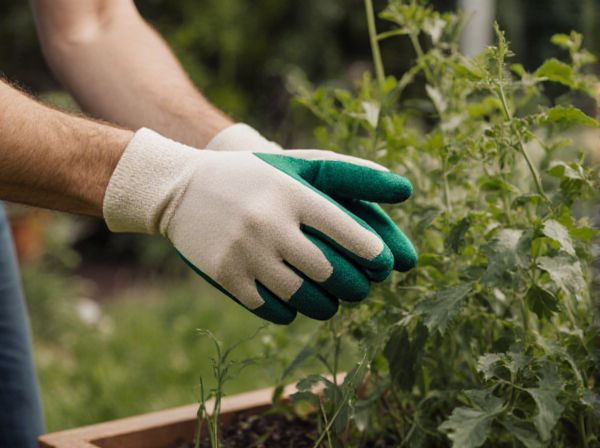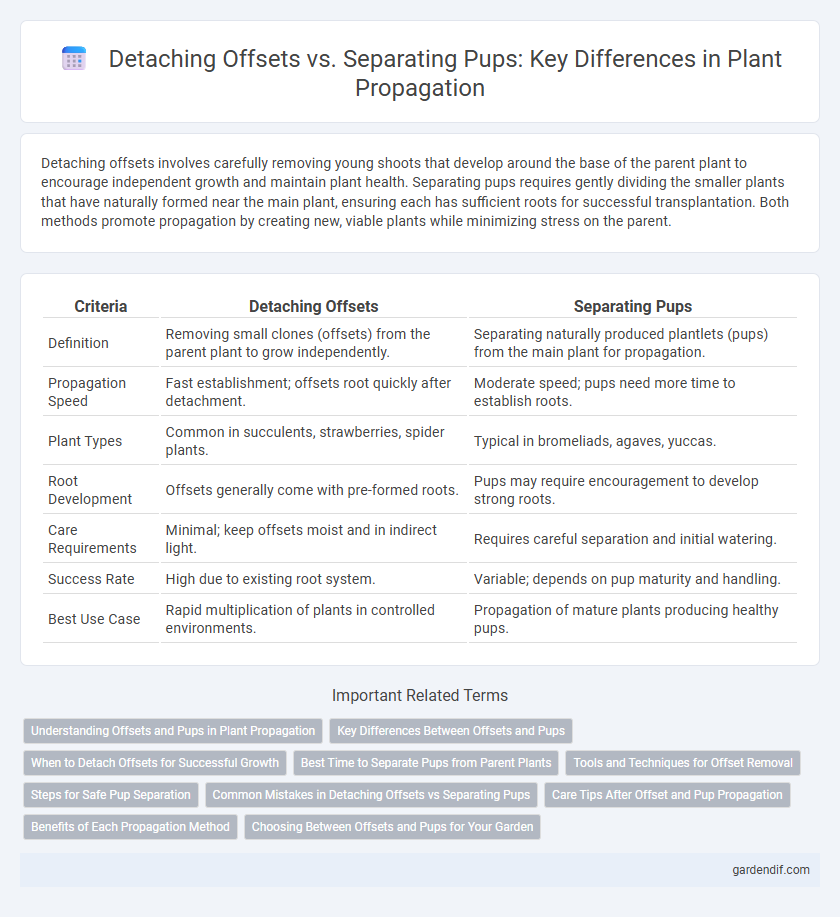
Detaching offsets vs Separating pups Illustration
Detaching offsets involves carefully removing young shoots that develop around the base of the parent plant to encourage independent growth and maintain plant health. Separating pups requires gently dividing the smaller plants that have naturally formed near the main plant, ensuring each has sufficient roots for successful transplantation. Both methods promote propagation by creating new, viable plants while minimizing stress on the parent.
Table of Comparison
| Criteria | Detaching Offsets | Separating Pups |
|---|---|---|
| Definition | Removing small clones (offsets) from the parent plant to grow independently. | Separating naturally produced plantlets (pups) from the main plant for propagation. |
| Propagation Speed | Fast establishment; offsets root quickly after detachment. | Moderate speed; pups need more time to establish roots. |
| Plant Types | Common in succulents, strawberries, spider plants. | Typical in bromeliads, agaves, yuccas. |
| Root Development | Offsets generally come with pre-formed roots. | Pups may require encouragement to develop strong roots. |
| Care Requirements | Minimal; keep offsets moist and in indirect light. | Requires careful separation and initial watering. |
| Success Rate | High due to existing root system. | Variable; depends on pup maturity and handling. |
| Best Use Case | Rapid multiplication of plants in controlled environments. | Propagation of mature plants producing healthy pups. |
Understanding Offsets and Pups in Plant Propagation
Offsets are specialized shoots that grow at the base of the parent plant, containing miniature versions of the mature plant; detaching them carefully ensures successful propagation and maintains genetic consistency. Pups, often found in succulents and agaves, are small plantlets that develop from the parent and can be separated when they have established roots, allowing independent growth. Understanding the differences between offsets and pups helps optimize propagation techniques by selecting the appropriate method for each plant type.
Key Differences Between Offsets and Pups
Detaching offsets involves removing small plantlets that grow from the base of the parent plant, allowing them to root independently, while separating pups refers to dividing the clumps formed by multiple offspring around the original plant. Offsets are typically smaller and require careful handling to avoid damage, whereas pups are often larger and more developed, making separation easier with minimal risk. Understanding these differences helps optimize propagation techniques for faster growth and healthier new plants.
When to Detach Offsets for Successful Growth
Detaching offsets is ideal when they have developed a robust root system, typically visible after 4-6 weeks of growth, ensuring successful transplantation and survival. Separating pups, on the other hand, is recommended when young plants form naturally at the base, indicating readiness for individual potting. Timing detachment based on root maturity significantly improves propagation success rates by reducing transplant shock and promoting healthy establishment.
Best Time to Separate Pups from Parent Plants
The best time to separate pups from parent plants is when the offsets develop their own roots and a few sets of leaves, typically after 2 to 3 months of growth. Detaching offsets too early can result in weak or unsuccessful propagation due to insufficient root development. Ensuring mature pups have established roots increases survival rates and promotes healthy independent growth.
Tools and Techniques for Offset Removal
Propagation techniques for detaching offsets involve specialized tools such as sharp pruning shears or pruning knives designed to make clean cuts without damaging the parent plant. Separating pups requires careful use of a pointed knife or garden trowel to gently loosen soil and sever root connections, minimizing stress and promoting faster root development. Sterilizing tools before and after use reduces the risk of disease transmission, ensuring healthy propagation of new plants.
Steps for Safe Pup Separation
When detaching offsets or separating pups for propagation, ensure the parent plant is healthy and the offsets have developed sufficient roots, typically 2-3 inches long. Use sterilized tools to carefully cut the offsets away, avoiding damage to both the parent plant and pups. After separation, plant pups in well-draining soil and maintain consistent moisture to encourage rooting and minimize transplant shock.
Common Mistakes in Detaching Offsets vs Separating Pups
Common mistakes in detaching offsets include damaging the parent plant by pulling too forcefully, which can lead to broken roots and reduced growth potential. Separating pups often involves improper timing, such as removing them before they develop sufficient roots, resulting in lower survival rates. Ensuring clean cuts with sterilized tools and allowing pups to establish strong root systems can significantly improve successful propagation outcomes.
Care Tips After Offset and Pup Propagation
Proper care after detaching offsets or separating pups ensures healthy propagation by maintaining consistent moisture levels while avoiding waterlogging to prevent root rot. Providing indirect, bright light promotes strong root and shoot development during the initial recovery phase. Applying a balanced, diluted fertilizer after a few weeks supports nutrient uptake essential for vigorous growth in propagated succulents.
Benefits of Each Propagation Method
Detaching offsets enables rapid multiplication of plants while maintaining genetic consistency, making it ideal for preserving desirable traits in succulents and houseplants. Separating pups promotes root and shoot development independently, resulting in stronger, more resilient new plants that adapt well to varied growing conditions. Both methods optimize propagation success by balancing growth speed and plant robustness according to the species' needs.
Choosing Between Offsets and Pups for Your Garden
Choosing between detaching offsets and separating pups depends on the plant species and growth habits; offsets are often preferred for succulents like aloe and echeveria due to their quick rooting ability. Separating pups works best for plants such as bromeliads and spider plants, where pups naturally develop from the parent and can be gently removed to propagate new plants. Assess the maturity and root development of the offsets or pups to ensure successful transplantation and healthy garden growth.
Detaching offsets vs Separating pups Infographic

 gardendif.com
gardendif.com